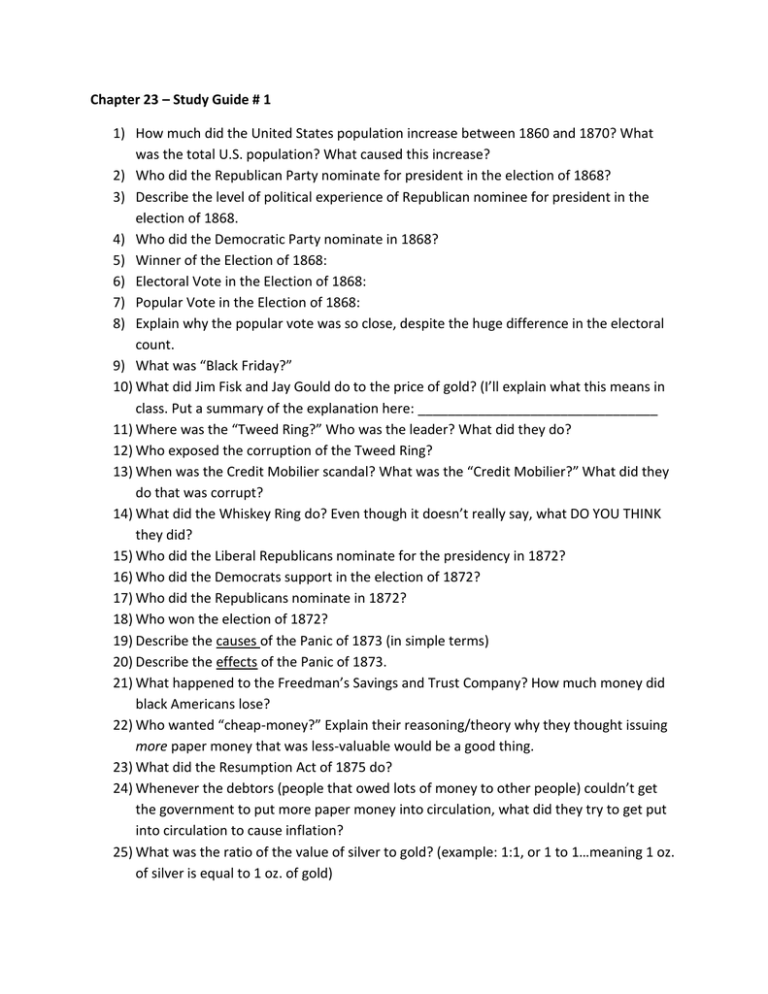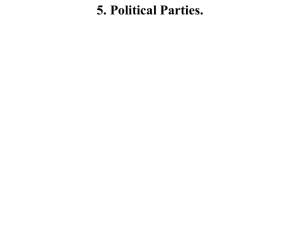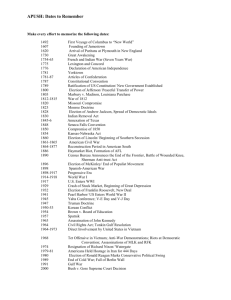Chapter 23 * Study Guide # 1
advertisement

Chapter 23 – Study Guide # 1 1) How much did the United States population increase between 1860 and 1870? What was the total U.S. population? What caused this increase? 2) Who did the Republican Party nominate for president in the election of 1868? 3) Describe the level of political experience of Republican nominee for president in the election of 1868. 4) Who did the Democratic Party nominate in 1868? 5) Winner of the Election of 1868: 6) Electoral Vote in the Election of 1868: 7) Popular Vote in the Election of 1868: 8) Explain why the popular vote was so close, despite the huge difference in the electoral count. 9) What was “Black Friday?” 10) What did Jim Fisk and Jay Gould do to the price of gold? (I’ll explain what this means in class. Put a summary of the explanation here: ________________________________ 11) Where was the “Tweed Ring?” Who was the leader? What did they do? 12) Who exposed the corruption of the Tweed Ring? 13) When was the Credit Mobilier scandal? What was the “Credit Mobilier?” What did they do that was corrupt? 14) What did the Whiskey Ring do? Even though it doesn’t really say, what DO YOU THINK they did? 15) Who did the Liberal Republicans nominate for the presidency in 1872? 16) Who did the Democrats support in the election of 1872? 17) Who did the Republicans nominate in 1872? 18) Who won the election of 1872? 19) Describe the causes of the Panic of 1873 (in simple terms) 20) Describe the effects of the Panic of 1873. 21) What happened to the Freedman’s Savings and Trust Company? How much money did black Americans lose? 22) Who wanted “cheap-money?” Explain their reasoning/theory why they thought issuing more paper money that was less-valuable would be a good thing. 23) What did the Resumption Act of 1875 do? 24) Whenever the debtors (people that owed lots of money to other people) couldn’t get the government to put more paper money into circulation, what did they try to get put into circulation to cause inflation? 25) What was the ratio of the value of silver to gold? (example: 1:1, or 1 to 1…meaning 1 oz. of silver is equal to 1 oz. of gold) Chapter 23 – Study Guide # 2 1) Where did the term “Gilded Age” come from, and what is it referring to? 2) What percentage of eligible voters voted in the presidential elections of the Gilded Age time period? Is that more or less than today? 3) What does it mean to vote “straight-ticket?” Did a lot of people do that during the Gilded Age? 4) How different were the economic views of the Democratic and Republican parties during the Gilded Age? 5) In what aspect were the two parties the most unlike one another? 6) Where did the Democratic party have its strongest support? (What part of the country?) 7) What was the GAR? 8) Describe “patronage” 9) What did the “Stalwart” faction of the Republican Party support? Who was their leader? 10) What group opposed the “Stalwart” faction of the Republican Party? Who was their leader? 11) Republican Party candidate in the Election of 1876: ____________________ 12) Democratic Party candidate in the Election of 1876: ___________________ 13) How many electoral votes did Tilden get? ____________ How many did he need? ______________ What 3 southern states were not accounted for? 14) Explain what the Constitution says should be done with Electoral votes (does it say who should count the votes….?) 15) Explain the “problem” that the government and Congress faced over who would count the electoral votes from the disputed states. 16) What was the Compromise of 1877 meant to do? 17) What did the Electoral Count Act do? 18) Explain the Compromise of 1877 (What did the Democrats agree to do? What did the Republicans agree to as part of the deal?) 19) Who won the Election of 1876 in the end? 20) Reconstruction ended when _______________________________. (What happened?) Chapter 23 – Study Guide # 3 1) Who were the “Redeemers?” 2) What types of treatment or harassment did blacks in the South face after the federal troops were removed from the South? 3) Explain the “crop-lien” system. 4) What were the state-level legal codes of segregation that many blacks in the South were under the oppression of by the 1890’s called? 5) What 3 ways did Southern states try to ensure that the black population of the South would not get to vote? 6) What did the Supreme Court rule in the court case of Plessy v. Ferguson? 7) How did south whites often deal with any black person who dared to assert themselves as equal to a white person? 8) Explain the reasons for the Great Railroad Strike in 1877. How did President Hayes try to resolve the strike? 9) In what state was 9% of the population Chinese? What did many Chinese immigrants do when the gold supply ran out and the Transcontinental RR was fully constructed? 10) Explain the Chinese Exclusion Act. 11) Explain the court case of U.S. v. Wong Kim Ark. 12) Who did the Republicans choose as their candidate in the Election of 1880? 13) Who was the Democratic Party’s candidate in the Election of 1880? 14) Who won the Election of 1880? 15) What happened to President Garfield? 16) Who became the President after what happened to President Garfield? 17) Describe the Pendleton Act. (What did it make illegal? What did it create? What was the Commission it created meant to do? 18) Who was the Republican Party’s nominee in the Election of 1884? 19) Who was the Democratic Party’s candidate for president in 1884? 20) What aspect of the Election of 1884 was most discussed, debated, and written about? 21) Who won the Election of 1884? 22) Before the introduction of income taxes, where did the majority of the federal government’s income come from? 23) Why did President Cleveland think that the tariff rates should be lowered? 24) Republican Candidate in the Election of 1888: ________________________ 25) Democratic Candidate in the Election of 1888: ________________________ 26) Who won the Election of 1888? 27) Why was the Republican-controlled Congress that began after the Election of 1888 called the “Billion-Dollar Congress?” 28) What did the McKinley Tariff Act of 1890 do? Who was the bill sponsored by? 29) What was the Farmer’s Alliance? 30) What were the “Populists?” 31) List the aspects of the Omaha Platform of the Populists: 1. ____________________ 5. _____________________ 2. ____________________ 6. _____________________ 3. ____________________ 7. _____________________ 4. ____________________ 8. _____________________ 32) 33) 34) 35) 36) Who was the People’s Party’s candidate for president in the Election of 1892? How many electoral votes did the Populists receive in the Election? Significance? Explain the “grandfather clause.” What was it meant to do? Who won the Election of 1892? Significance? What party was he from? Why did the President engineer a repeal of the Sherman Silver Purchase Act of 1890? (What was happening to the Treasury’s gold reserve? How much did it need to support the paper money that was in circulation? 37) Who was J.P. Morgan? What did he do to help the government out when the country’s gold reserves were down to $41 million? 38) What was the Wilson-Gorman Tariff of 1894 supposed to do? Why was it not effective? What else did it include? 39) What are the presidents of the Gilded Age (Grant, Hayes, Garfield, Arthur, Harrison, and Cleveland) often referred to as? Why? - DUE ON MONDAY, JANUARY 1ST (THE FIRST DAY BACK) - WE WILL HAVE A QUIZ ON CHAPTER 23 ON MONDAY (10-15 QUESTIONS) - WE WILL HAVE A TEST ON CHAPTER 23 ON TUESDAY, JANUARY 7TH * I will also post these Study Guides on my webpage, in case your lose them * If you have any questions, post them to Twitter, or you can e-mail me (p.s. I’m not having you do this over break because I am mean, but rather because 1) I don’t want you to forget too much, and 2) because after Tuesday of the first week back, we will be watching a movie for the rest of the week!) HAVE A GREAT CHRISTMAS BREAK! - EARNHARDT


